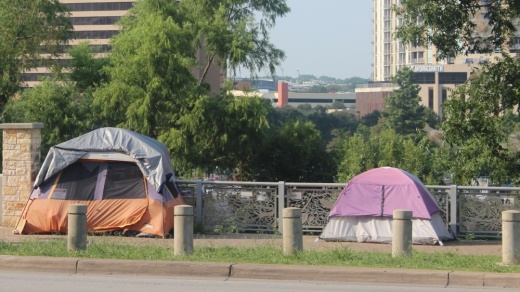During a May 11 briefing to City Council’s committee on public health, Homeless Strategy Officer Dianna Grey told officials the need to address encampments continues to outpace the city's ability to adequately respond. That outlook is similar to a status update Grey provided council earlier this year, although staff are now moving forward with new strategies and data tracking in hopes of streamlining their work.
While homeless response involves multiple city departments, those most affected include Austin Resource Recovery and the Austin Public Works and Watershed Protection departments. Since last year, Grey said those three alone have been responsible for responding to an average of 68 encampments and clearing away nearly 140 tons of trash on a monthly basis. In addition, the Austin Parks and Recreation Department and Austin Police Department are also frequently involved in homeless encampment work.
On that front, Austin has experienced issues including disjointed responses to service requests, conflicting department data systems, and burnout and a lack of resources among staff, city consultant Audrey Muntz said. This summer, a centralized team is set to launch in part to address those issues while a revamped tool to target priority encampments between all involved departments is also being rolled out.
Even with those potential improvements, both staff and city officials acknowledged complications will endure until higher numbers of people living on the streets can be linked with a permanent place to stay.
“As we continue to make progress on the recommendations, I do believe we will be able to minimize many of those pain points that I shared earlier,” Muntz said. “I do want to acknowledge that without the root-cause solution of housing, that many of those pain points—including the cyclical nature of the work, the trauma of repeat displacement for persons experiencing homelessness, frustration from community members and challenges managing limited resources—will remain to some extent.” The May council briefing was held one week after two community events providing updates on the city’s broader work addressing homelessness. The discussions come one year after the city voted to re-enact ordinances aimed at homelessness that criminalized camping, sitting, lying down or sleeping in public. Enforcement of that measure, Proposition B, ramped up through several phases last summer following the election.
According to data tracked by the Ending Community Homelessness Coalition, Austin's camping ban appears to have had no effect on lowering the number of people experiencing homelessness over the past year. ECHO estimates show a 21.71% increase in the region's homeless population between April 2021—just before Proposition B passed and camping was restricted—and April 2022.
Austin also is working to spend tens of millions of dollars on housing and supportive services council authorized last year. The regional Finding Home ATX initiative, a $515 million plan to house thousands of people through 2024, also remains in the works among city, nonprofit, business and philanthropic stakeholders.
“We need to recognize that there will be no answer to this; there will be no disappearing of encampments; there will be no thorough and exhaustive placement of people into homes until we have places for people to be,” said Mayor Steve Adler, a Finding Home stakeholder. “Unfortunately, we could have been doing this years and years ago to build out the infrastructure so that we had that infrastructure in place. And we don’t, so we’re now trying to catch up.”
Parks response, health concerns
During Grey’s May 11 discussion with city officials, District 9 Council Member Kathie Tovo also highlighted the lacking resources some departments still have when directly assisting those experiencing homelessness on parkland.
After hearing a story involving someone camping out in a playground feature, Tovo said she remains concerned about the speed and effectiveness of individual responses given how frequently camps pop up in public parks. Muntz said standard policy is to ask for voluntary compliance in such situations. However, if no city staff are in the area, then immediate action is unlikely. A lack of available shelter or housing space can also make relocation difficult.
“It sounds like that is the practice, but that [the parks and recreation department] is woefully understaffed to provide that kind of outreach,” Tovo said. “That’s an issue that needs addressing since a lot of these instances are happening on parkland.”
District 1 Council Member Natasha Harper-Madison also asked homeless strategy officials to consider behavioral health issues as the city ramps up its homelessness spending this year. Grey said staff are pressing for more services related to those needs in the city's solicitation packages, especially given that upwards of 50% of the city’s homeless population is contending with mental health challenges or a substance use disorder.
On top of higher-level city strategy, Harper-Madison also said work in neighborhoods can be an essential part of Austin’s response. As an example of smaller-scale successes around town, she pointed to one District 1 resident who she said has opened his home and resources to residents experiencing homelessness in an effort to support members of a local encampment.
“At that community level, what he’s doing is helping dozens of people. And I want to figure out how we can duplicate the model. He just happened to be innovative and wanted to be part of the solution,” she said.





